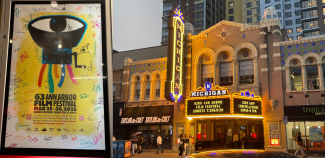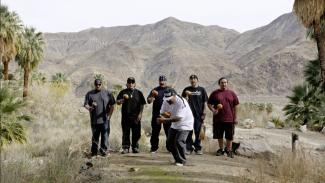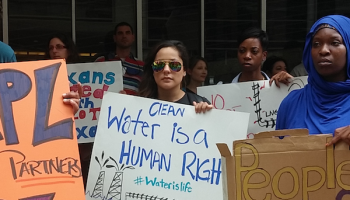By Yuki Nakayama, Ecology Center Environmental Storyteller Rackham Fellow

The Ann Arbor Film Festival is the longest-running experimental film festival in North America. It is also an Oscar-qualifying festival, meaning that award winners at the festival are automatically considered for the Academy Awards. Ecology Center is excited to be involved with the festival as a community partner — every year, we sponsor a screening of a film in competition that touches on environment related themes.
At this year’s 63rd Ann Arbor Film Festival (March 25 , 2025 to March 30, 2025), Ecology Center sponsored a screening of AMONG THE PALMS THE BOMB or: Looking for reflections in the toxic field of plenty (Lukas Marxt and Vanja Smiljanić, 2024). This documentary feature film won the “It’s a good idea not to blow people up with nuclear bombs” Jury Award.
The film focuses on the Salton Sea in southern California. Although it is called a “sea,” it is the largest lake in California, located just south of Coachella and Joshua Tree National Park. The Salton Sea is most known for atomic bomb testing by the U.S. military during World War II. Currently, the Salton Sea and its surrounding areas are known for high levels of toxicity in the water and debris. Recently, it has also attracted attention due to the discovery of 18 million metric tons of lithium (roughly worth $540 billion) underneath the lake, which is a crucial material for green energy. This makes the Salton Sea one of the largest lithium deposits in the world.
The film gently unravels how humans and the environment are tightly intertwined. We impact the environment as much as the environment impacts us. It intricately weaves together the history and current status of the Salton Sea by including the history of bomb testing, the indigenous communities that live near and oversee the area, its impact to local environments, and its relationship to contemporary agriculture industry. The film is a story about the environment and all of the various people involved in its observation, preservation, and consumption. It shows us the ripple effects of human impact on the environment and its inhabitants.
“The Salton Sea has many stories. The atomic bomb testing is just one of them.” This statement, by a member of the Torres Martinez Desert Cahuilla Indians, captures the overall tone and approach of the film. It gives us snapshots of stories and developments the lake has witnessed over time. Punctuated by a group of tribal members singing traditional songs, the film connects the genocide of Native Americans in the 19th century to the ongoing destruction of native plants by the modern monocultural agriculture industry. The indigenous communities have also started to serve as safe havens for undocumented migrant workers, who have become a crucial part of modern farming. The tribal members continue to live in harmony with these sacred lands through its changes.

There appears to be a never-ending cycle of environmental and health harms caused by evolving socio-political interests. The toxicity of the lake’s water is largely due to the heavy metals, chemicals, and radioactive materials deposited by the U.S. military during World War II and the Cold War, as the debris and materials from tested bombs remain in the lake and its surrounding areas. The accelerating climate change is causing the water level at the Salton Sea to decrease at an alarming rate, with little investment by those in power to save it. The highly toxic dust from the lake can also spread by the wind to residential and agricultural areas, raising major concerns.
The film uses point-of-view shots throughout, providing us with unique perspectives on the stories of the Salton Sea. We are not allowed to sit back and be passive observers; these shots compel us to be aware of our complicity in the history and current status of the lake, as well as the political and environmental conditions beyond it.
With the recent discovery of Lithium, the Salton Sea will attract increased military, political, and business interests, as the lithium reserve is large enough to meet all domestic lithium needs without importing from China. There are plans for a “Lithium Valley” in California to develop a lithium industry, but new industrial developments raise new environmental concerns, such as the impact to local water supplies and other issues.
Among the Palms the Bomb uses a micro view of the Salton Sea as an entry point to examine the macro issues that continue to impact environmental and human health on a larger scale. The Salton Sea’s stories are not unique to this area. There are many other contamination sites across the US that continue to require our involvement, including right here in Michigan such as Ossineke GroundWater Site, Groundwater in Traverse City, Verona Well Field and many more (more information about other contaminated sites in the US available on EPA’s Website). The film’s power lies in the way it reminds us about the universality of the entangled interests and realities that influence possible solutions.


